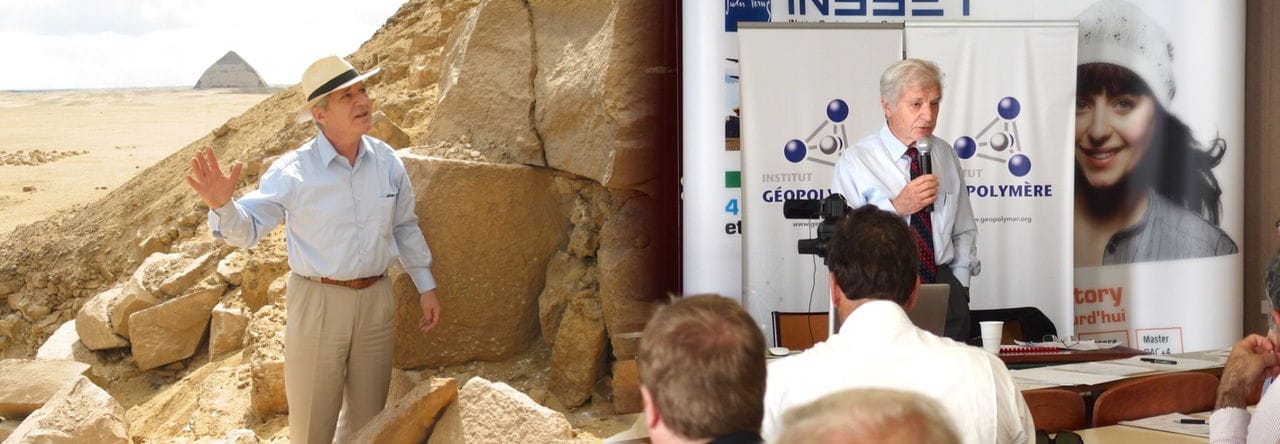The world press is commenting the study published by the French science magazine Science & Vie and the scientific paper released by the Journal of the American Ceramic Society , December 2006.
Here some links and excerpts from major English, American and German news papers
Materials Science: Concrete evidence
The scientific magazine NATURE, vol. 444, p. 793 (14 december 2006) writes in his News about the recent analysis on pyramid stones:
“Some of the massive blocks making up the great pyramids of Giza in Egypt (pictured) are not limestone, but a synthetic mix like concrete, argue materials scientists. The paper by Michel Barsoum of Drexel University in Philadelphia, Pennsylvania, and his colleagues is the latest entry in a decades-long argument. Most Egyptologists reject the idea, put forth in the mid-1980s by French chemist Joseph Davidovits, that the pyramids contain concrete. Barsoum’s team took a fresh look at 15 samples using scanning- and transmission-electron microscopes. The samples contain ratios of elements, such as calcium and magnesium, that do not exist in nearby limestone. The imaging also revealed regions of amorphous structure. Both observations suggest that other substances were added to make a concrete mix, say the authors.
Pyramids were built with concrete rather than rocks, scientists claim
The London Times, December 1, 2006
“The research, by materials scientists from national institutions, adds fuel to a theory that the pharaohs’ craftsmen had enough skill and materials at hand to cast the two-tonne limestone blocks that dress the Cheops and other Pyramids. (…) according to Professor Gilles Hug, of the French National Aerospace Research Agency (Onera and CNRS), and Professor Michel Barsoum, of Drexel University in Philadelphia: “There’s no way around it. The chemistry is well and truly different.” Their study is being published this month in the Journal of the American Ceramic Society. (…) The professors agree with the “Davidovits theory” that soft limestone was quarried on the damp south side of the Giza Plateau. This was then dissolved in large, Nile-fed pools until it became a watery slurry”
Scientist Says Concrete Was Used in Pyramids
The New York Times, December 1, 2006
The article contains the same information with an additional and very important one, namely the statement by Dr. Zahi Hawass, General Secretary of the Egyptian Antiquity Organisation. I quote :
Zahi Hawass, secretary-general of antiquities in Egypt and director of the Giza Pyramids excavations, said in an e-mail message, “The idea that concrete was used is unlikely and completely unproven.” Noting that the pyramids have been restored and reinforced many times with the extensive use of concrete, Dr. Hawass said, “I would ask Dr. Barsoum the question: where did he get the samples he is working with, and how can he show that the samples are not taken from areas that have been restored in modern times?”
We have additional information in the German Press that mentions Geopolymer-Stones.
Pyramiden aus “Beton”-Quadern
Die Welt (Germany) December 2, 2006
(…) Haben die alten Ägypter die Steine für die Pyramiden aus einer Art antikem Beton gegossen? Aktuelle Studien zeigen, dass bestimmte Mikro-Bestandteile der Steine Spuren einer schnellen chemischen Reaktion aufweisen (…). Guy Demortier von der belgischen Universität von Namur habe zudem festgestellt, dass die Pyramidensteine mehr Fluor, Silizium, Magnesium und Natrium aufwiesen als Natursteine. “Auch wenn es den Ägyptologen nicht gefällt: Die Nutzung von Geopolymeren für den Bau der Pyramiden ist die wahrscheinlichste Variante.” Nach Ansicht des Chemikers Joseph Davidovits, der die Geopolymer-These seit 30 Jahren vertritt, bestehen die gegossenen Steine zu 93 bis 97 Prozent aus Naturkalk, zu drei bis sieben Prozent aus dem Bindemittel Kaolinit-Ton.
 In English
In English En Français
En Français